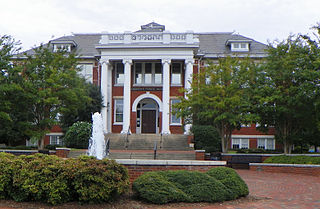
Mount Olive is a town in Duplin and Wayne counties in the U.S. state of North Carolina. The population was 4,589 at the 2010 census. It is included in the Goldsboro, North Carolina Metropolitan Statistical Area. The town is home to the Mt. Olive Pickle Company and the University of Mount Olive.

The University of Mount Olive is a private university in Mount Olive, North Carolina. Chartered in 1951, the university is sponsored by the Original Free Will Baptist Convention and accredited by the Southern Association of Colleges and Schools Commission on Colleges. A member of the NCAA Division II Conference Carolinas, its sports teams compete as the Mount Olive Trojans.

Saint Mary's School is a private independent Episcopal college-preparatory, boarding and day school for girls in grades 9–12. Located in Raleigh, North Carolina, Saint Mary's School operates as an independent school with a historic association with the Episcopal Church including an Episcopal chapel, St. Mary's Chapel, on the school's grounds. The school formerly operated as Saint Mary's College and for many decades educated young women in grades 11–12 and their freshman and sophomore years in college. The school changed to a four year high school in 1998, at which point the name reverted to Saint Mary's School, the original name of the institution when it was founded in 1842.

Egg Rock Light is a lighthouse on Frenchman Bay, Maine. Built in 1875, it is one of coastal Maine's architecturally unique lighthouses, with a square tower projecting through the square keeper's house. Located on Egg Rock, midway between Mount Desert Island and the Schoodic Peninsula, it is an active aid to navigation, flashing red every 40 seconds. The light was listed on the National Register of Historic Places as Egg Rock Light Station in 1988.

Mount Zion Baptist Church is a historic African-American Baptist church located at 413 N. Church Street in Salisbury, Rowan County, North Carolina. The sanctuary was built in 1907, and is a red brick Gothic Revival style building. It features stained glass lancet windows and small triangular shaped windows and former towers capped by octagonal conical roofs. A brick-veneered educational/manse wing added between 1913 and 1920.

The Central School, also known as Laurinburg Graded School, is a historic school building located at Laurinburg, Scotland County, North Carolina. The original section was designed by architect Oliver Duke Wheeler and built in 1909–1910. It is a two-story, brick building in Neoclassical style. The main entrance features a prominent central portico with four Doric order columns. Two-story flanking wings were added in 1939, and additions to the wings were made in 1948 and 1949 and designed by Leslie Boney. The school closed in 2000.

The Gate School is the historic former school in Gate, Oklahoma. The yellow brick building was constructed by the Works Progress Administration from 1937 to 1938. The new school building replaced an existing school; due to budgetary constraints, the WPA reused materials from the previous school in the new building. The WPA worked extensively in Beaver County, which includes Gate, due to the Dust Bowl's impact on the local economy, and the new Gate School was one of several WPA-built school buildings in the county. The school served as the local elementary and high school until the high school consolidated with the Laverne school district in 1972; the elementary school followed suit in 1992.

Ravenscroft School, also known as Chateau Nollman, is a historic school building located at Asheville, Buncombe County, North Carolina. The oldest section was built about 1845, and is a two- to three-story brick building in the Greek Revival style. It consists of a squat, three-story, pyramidal-roofed tower with projecting two-story rectangular wings. The building has a number of later additions including a two-story brick wing and two-story frame wing. It was originally built as a residence, and housed a school from 1856 to the turn of the 20th century. It was used as a boarding or rooming house until 1977. The building is currently used as office space.

Siler City High School, also known as the Paul Braxton School, is a historic high school building located at Siler City, Chatham County, North Carolina. It was built in 1922, and is a two-story, "T"-shaped, five-bay school building with streamlined Art Deco design elements. It has a two-story-high auditorium wing. Also on the property are the contributing mid-1930s one-story brick woodworking shop building which now serves as a community center, a 1 1/2-story frame gymnasium begun in 1930, and an early 1930s dirt baseball field which was initially a football field.

Pomona High School, Former, also known as Lindley Junior High School, is a historic school building located at Greensboro, Guilford County, North Carolina. The original section was built about 1920, and is a two-story, nine bay, "U"-shaped, Classical Revival style building. Two projecting wings were added in 1940, and in 1951, the space was filled between the wings. It is faced with dark bricks accented with limestone, concrete, and terra cotta ornament. The building features a one-story limestone entrance portico supported by four Doric order columns. The school closed in 1979. It has been converted to apartments.

Jamestown High School, Former, also known as Jamestown Public School, is a historic school building located at Jamestown, Guilford County, North Carolina. It was designed by architect Charles E. Hartge and built in 1915. It is a 2 1/2-story, Classical Revival style brick building with cast stone detailing. It features a full-height tetrastyle entrance portico supported by Ionic order columns and pilasters. The building underwent a major rehabilitation and adaptive reuse in 1986 and 1987.

Roanoke Rapids Historic District is a national historic district located at Roanoke Rapids, Halifax County, North Carolina. It encompasses 1,130 contributing buildings, 5 contributing sites, 27 contributing structures, and 1 contributing structure in the central business district and surrounding residential sections of the town of Roanoke Rapids. The district includes notable examples of Queen Anne, Colonial Revival, and Bungalow / American Craftsman style architecture. Located in the district is the separately listed Roanoke Rapids High School. Other notable buildings include workers houses in four local mill villages, Driscoll-Piland-Webb House, Dickens-Webb House (1906-1907), Samuel F. Patterson (1914-1915), Council-Coburn House (1925-1927), First Presbyterian Church (1915), All Saints Episcopal Church designed by Hobart Upjohn (1917), (former) First Baptist Church (1928-1929), (former) Nurses Home and School (1930-1931), Clara Hearne Elementary School (1933-1935), (former) North Carolina National Guard Armory (1940-1941), (former) United States Post Office (1937-1938), Rosemary Drug Co. Building (1915-1916), Shelton Hotel, First National Bank Building (1914-1915), J. C. Penney and Co. Building (1938-1942), McCrory Co. Building (1940), Imperial Theatre Building, (former) Seaboard Air Line Passenger Station (1917), Rosemary Manufacturing Company complex, Patterson Mills Co. (1910), and Roanoke Mills Co. Plant No. 2. (1916-1917).

The former Sanford High School, also known as West Sanford Middle School, is a historic high school building located at Sanford, Lee County, North Carolina. It was designed by the firm of Wilson, Berryman & Kennedy and built in 1924–1925. It is a two-story, "L"-shaped, Classical Revival style brick building. The front facade features a slightly projecting center pavilion and terminal pavilions with concrete-faced pilasters with enriched capitals. The building houses the Lee County Art and Community Center.

The former Reidsville High School, also known as Reidsville Junior High School and Reidsville Middle School, is a historic school building located at Reidsville, Rockingham County, North Carolina. It was designed by architect Willard C. Northup and built in 1923. It is a three-story, "L"-shaped, brick building with a combination of Colonial and Classical Revival stylistic features. A matching one-bay addition was built in 1941. It features a two-story tetrastyle portico of Tuscan order columns and terra cotta trim. It ceased use as a high school in 1960, with the construction of Reidsville High School and the building closed permanently as a school in 1980.

Southerland-Burnette House is a historic home in the Mount Olive Historic District in Mount Olive, Wayne County, North Carolina. It was built about 1874 and extensively altered in 1924 in the Classical Revival style. It is a two-story, three-bay, frame dwelling with a gable roof. The front facade features a two-story tetra-style portico with Tuscan order columns.
Vernon, also known as the Anna Maria Ward House, was a historic plantation house located near Mount Olive, Wayne County, North Carolina. It was built about 1837, and was a two-story, five bay by two bay, Federal style frame dwelling. It sat on a brick pier foundation and one-story shed porch that replaced a mid-19th century two-story porch of Italianate design. It has been demolished.

The former United States Post Office is a historic post office building located at Mount Olive, Wayne County, North Carolina. It was designed by the Office of the Supervising Architect under James A. Wetmore and built in 1931–1933. It is a two-story, seven bay, "T"-shaped, brick building in the Classical Revival style. The central five bays of the front facade features a colonnade of six unfluted Roman Ionic order columns in antis. The building has been converted to office space.

Mount Olive Historic District is a national historic district located at Mount Olive, Wayne County, North Carolina. The district encompasses 465 contributing buildings, 2 contributing structures, and 1 contributing object in the central business district and surrounding residential sections of Mount Olive. It developed between about 1838 and 1949, and includes notable examples of Italianate and Queen Anne style architecture. Located in the district are the separately listed former United States Post Office, Mount Olive High School (Former), Southerland-Burnette House, and Perry-Cherry House. Other notable contributing buildings are the Elms, Mount Olive Presbyterian Church (1916), Carver High School (1941), Wooten & Brothers Building, DeBrutz English House, Center Theatre (1947), Mount Olive Manufacturing Company (1914), Farrior-Wooten House, Mount Olive First United Methodist Church (1911-1913), Mt. Olive Pickle Co. Office (1920), Mount Olive Passenger Depot, and Ebenezer Apostolic Holiness Church (1850).

L. D. Giddens and Son Jewelry Store is a historic commercial building located at Goldsboro, Wayne County, North Carolina. It was built between 1839 and 1847, and is a two-story, three bay, brick building. It measures 104 feet long and 23 feet, 6 inches wide. It features cast iron ornamentation and a freestanding clock (1877) at the street measuring 14 feet high. L. D. Giddens and Son was founded in 1859 and may be the oldest jewelry store in North Carolina.
John David Gullett was an American architect based in Goldsboro in Wayne County, North Carolina. He practiced in North Carolina from 1920 until his death in 1935. Several of his works are listed on the National Register of Historic Places (NRHP).



















